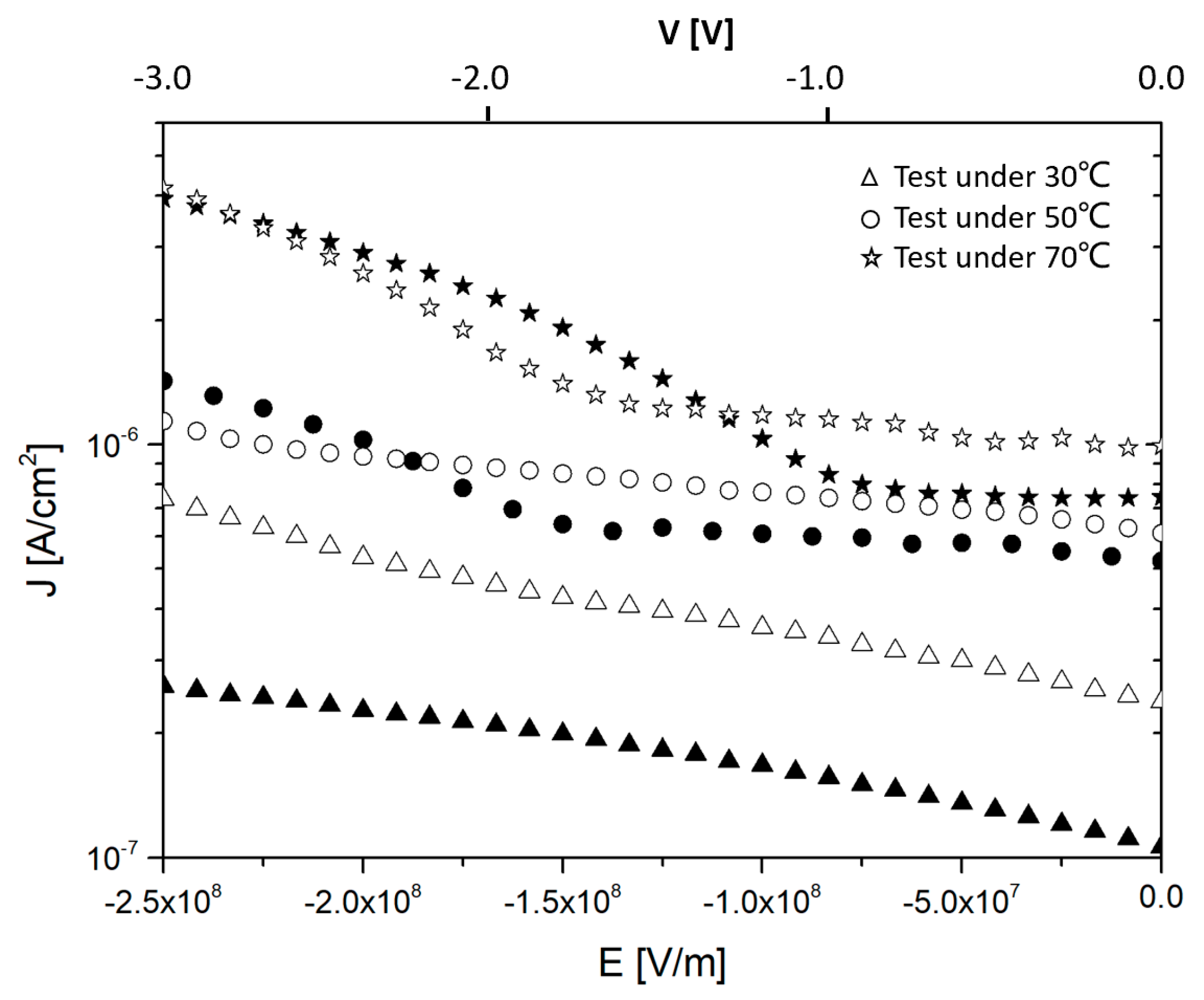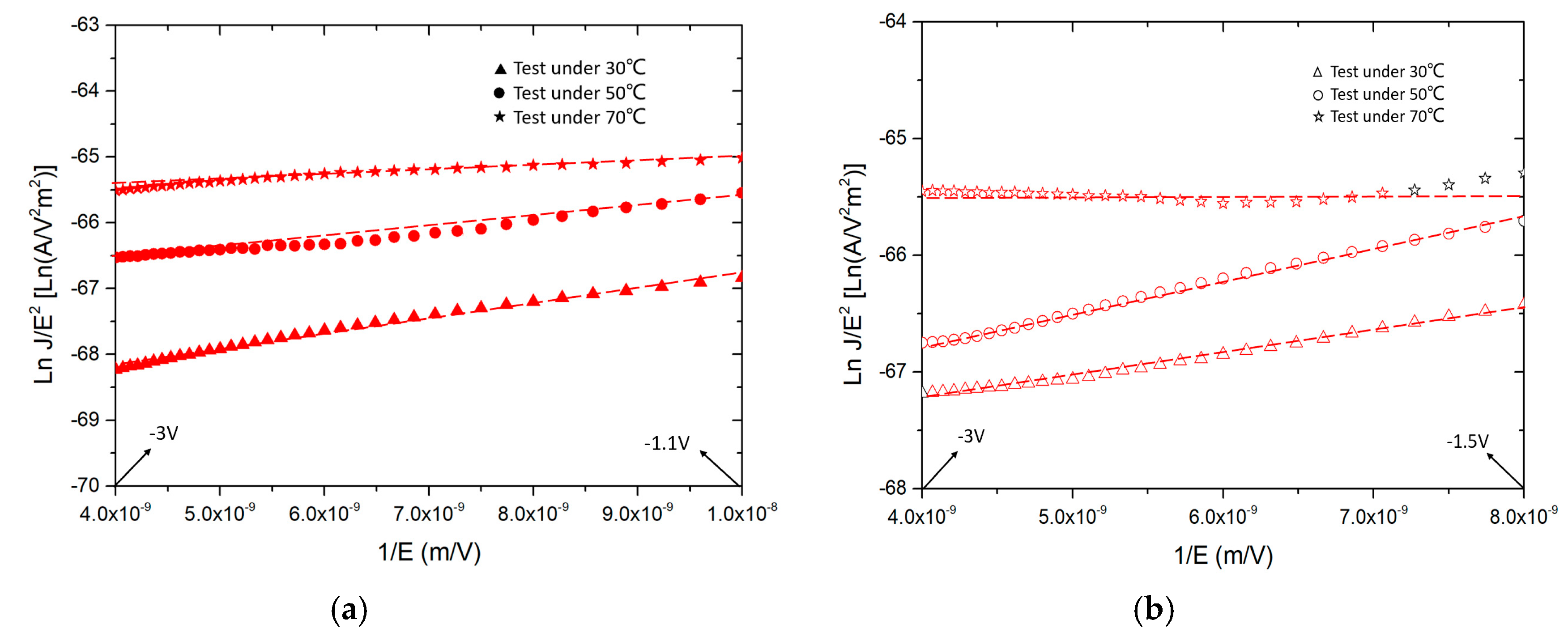Leakage Current Conduction Mechanism of Au-Pt-Ti/ HfO2-Al2O3/n-InAlAs Metal-Oxide-Semiconductor Capacitor under Reverse-Biased Condition
Abstract
1. Introduction
2. Experiment
3. Measurement and Discussion
4. Discussion
Author Contributions
Funding
Conflicts of Interest
References
- Moschetti, G.; Wadefalk, N.; Nilsson, P.A.; Roelens, Y.; Noudeviwa, A.; Desplanque, L.; Wallart, X.; Danneville, F.; Dambrine, G.; Bollaert, S.; et al. InAs/AlSb HEMTs for cryogenic LNAs at ultra-low power dissipation. Solid-State Electron. 2011, 64, 47–53. [Google Scholar] [CrossRef]
- Moschetti, G.; Nilsson, P.; Wadefalk, N.; Malmkvist, M.; Lefebvre, E.; Grahn, J. DC characteristics of InAs/AlSb HEMTs at cryogenic temperatures. In Proceedings of the Indium Phosphide & Related Materials (IPRM) International Conference, Newport Beach, CA, USA, 10–14 May 2009; p. 323. [Google Scholar]
- Malmkvist, M.; Lefebvre, E.; Borg, M.; Desplanque, L.; Wallart, X.; Dambrine, G.; Bollaert, S.; Grahn, J. Electrical characterization and small-signal modeling of InAs/AlSb HEMTs for low-noise and high-frequency applications. IEEE Trans. Microw. Theory Tech. 2008, 56, 2685–2691. [Google Scholar] [CrossRef]
- Moschetti, G.; Wadefalk, N.; Nilsson, P.A.; Abbasi, M.; Desplanque, L.; Wallart, X.; Grahn, J. Cryogenic InAs/AlSb HEMT wideband low-noise IF amplifier for ultra-low-power applications. IEEE Microw. Wirel. Compon. Lett. 2012, 22, 144–146. [Google Scholar] [CrossRef]
- Malmkvist, M.; Lefebvre, E.; Borg, M. Characterization of insulated-gate versus schottky-gate InAs/AlSb HEMTs. In Proceedings of the European Microwave Integrated Circuit Conference, Munich, Germany, 8–10 October 2007. [Google Scholar]
- Hashizume, T.; Ootomo, S.; Inagaki, T.; Hasegawa, H. Surface passivation of GaN and GaN/AlGaN heterostructures by dielectric films and its application to insulated-gate heterostructure transistors. J. Vac. Sci. Technol. B 2003, 21, 1828. [Google Scholar] [CrossRef]
- Hashizume, T.; Anantathanasarn, S.; Negoro, N.; Sano, E.; Hasegawa, H.; Kumakura, K.; Makimoto, T. Al2O3 insulated-gate structure for AlGaN/GaN heterostructure field effect transistors having thin AlGaN barrier layers. Jpn. J. Appl. Phys. 2004, 43, 777. [Google Scholar] [CrossRef]
- Trinh, H.D.; Lin, Y.C.; Wang, H.C.; Chang, C.H.; Kakushima, K.; Iwai, H. Effect of Postdeposition Annealing Temperatures on Electrical Characteristics of Molecular-Beam-Deposited HfO2 on n-InAs/InGaAs Metal–Oxide–Semiconductor Capacitors. Appl. Phys. Express 2012, 5, 1104. [Google Scholar] [CrossRef]
- Brennan, B.; Galatage, R.V.; Thomas, K.; Pelucchi, E.; Hurley, P.K.; Kim, J.; Hinkle, C.L.; Vogel, E.M.; Wallace, R.M. Chemical and electrical characterization of the HfO2/InAlAs interface. J. Appl. Phys. 2013, 114, 104103. [Google Scholar] [CrossRef]
- Liu, C.; Zhang, Y.M.; Zhang, Y.M.; Lv, H.L. Interfacial characteristics of Al/Al2O3/ZnO/n-GaAs MOS capacitor. Chin. Phys. B. 2013, 22, 076701. [Google Scholar] [CrossRef]
- Jin, C.J.; Lv, H.L.; Zhang, Y.M.; Guan, H.; Li, Z.; Zhang, Y. Study on reverse-biased gate leakage current mechanisms in Al2O3/InAlAs metal-oxide-semiconductor structures. Thin Solid Films 2016, 619, 48–52. [Google Scholar] [CrossRef]
- Jin, C.J.; Lv, H.L.; Zhang, Y.M.; Guan, H.; Wu, L.; Lu, B.; Liu, C. Transport mechanisms of leakage current in Al2O3/InAlAs MOS capacitors. Solid-State Electron. 2016, 123, 106–110. [Google Scholar] [CrossRef]
- Wu, L.; Zhang, Y.; Lv, H.; Zhang, Y. Interfacial and electrical characterization of HfO2/Al2O3/InAlAs structures. Jpn. J. Appl. Phys. 2015, 54, 110303. [Google Scholar] [CrossRef]
- Guan, H.; Jing, C.Y. Study on the Physical and Leakage Current Characteristics of an Optimized High-k/InAlAs MOS Capacitor with a HfO2–Al2O3 Laminated Dielectric. Coatings 2018, 8, 417. [Google Scholar] [CrossRef]
- Guan, H.; Lv, H. Study on leakage current mechanism and band offset of high-k/n-InAlAs metal-oxide-semiconductor capacitors with HfO2 and HfAlO dielectric. Thin Solid Films 2018, 661, 137–142. [Google Scholar] [CrossRef]
- Lin, Y.C.; Hai, D.T.; Chuang, T.W.; Iwai, H.; Kakushima, K.; Ahmet, P.; Lin, C.H.; Diaz, C.H.; Chang, H.C.; Jiang, S.M.; et al. Electrical Characterization and Materials Stability Analysis ofLa2O3/HfO2 Composite Oxides on n-In0.53Ga0.47AsMOS Capacitors With Different Annealing Temperatures. IEEE Electron Device Lett. 2013, 34, 1229. [Google Scholar] [CrossRef]
- Galatage, R.V.; Dong, H.; Zhernokletov, D.M.; Brennan, B.; Hinkle, C.L.; Wallace, R.M.; Vogel, E.M. Effect of post deposition anneal on the characteristics of HfO2/InP metal-oxide-semiconductor capacitor. Appl. Phys. Lett. 2011, 99, 172901. [Google Scholar] [CrossRef]
- Park, J.; Cho, M.; Kim, S.K.; Park, T.J.; Lee, S.W.; Hong, S.H.; Hwang, C.S. Influence of the oxygen concentration of atomic-layer-deposited HfO2 films on the dielectric property and interface trap density. Appl. Phys. Lett. 2005, 86, 112907. [Google Scholar] [CrossRef]
- Galatage, R.V.; Dong, H.; Zhernokletov, D.M. Electrical and chemical characteristics of Al2O3/InP metal-oxide-semiconductor capacitors. Appl. Phys. Lett. 2013, 102, 122109. [Google Scholar] [CrossRef]
- Wheeler, D.C. High-k-InAs metal-oxide-semiconductor capacitors formed by atomic-layer deposition. Ph.D. Thesis, University of Notre Dame, Notre Dame, IN, USA, April 2009. [Google Scholar]
- Huang, M.L.; Chang, Y.C.; Chang, Y.H.; Lin, T.D.; Kwo, J.; Hong, M. Energy-band parameters of atomic layer deposited Al2O3 and HfO2 on InxGa1−xAs. Appl. Phys. Lett. 2009, 94, 052106. [Google Scholar] [CrossRef]
- Suri, R.; Kirkpatrick, C.J.; Lichtenwalner, D.J.; Misra, V. Energy-band alignment of Al2O3 and HfAlO gate dielectrics deposited by atomic layer deposition on 4H–SiC. Appl. Phys. Lett. 2010, 96, 042903. [Google Scholar] [CrossRef]
- Yu, H.Y.; Wu, N.; Li, M.F.; Zhu, C.; Cho, B.J. Thermal stability of (HfO2)x(Al2O3)1−x. Appl. Phys. Lett. 2002, 81, 3618–3620. [Google Scholar] [CrossRef]
- Suzuki, R.; Taoka, N.; Yokoyama, M.; Lee, S.; Kim, S.H.; HoshiIl, T.; Yasuda, T.; Jevasuwan, W.; Maeda, T.; Ichikawa, O.; et al. 1-nm-capacitance-equivalent-thickness HfO2/Al2O3/InGaAs metal-oxide-semiconductor structure with low interface trap density and low gate leakage current density. Appl. Phys. Lett. 2012, 100, 132906. [Google Scholar] [CrossRef]
- Quah, H.J.; Cheong, K.Y. Current conduction mechanisms of RF-magnetron sputtered Y2O3 gate oxide on gallium nitride. Curr. Appl. Phys. 2013, 13, 1433–1439. [Google Scholar] [CrossRef]
- Chiu, F.C. Electrical characterization and current transportation in metal∕ Dy2O3∕ Si structure. J. Appl. Phys. 2007, 102, 044116. [Google Scholar] [CrossRef]
- Cheong, K.Y.; Moon, J.H.; Kim, H.J.; Bahng, W.; Kim, N.K. Current conduction mechanisms in atomic-layer-deposited HfO2/nitride SiO2 stacked gate on 4H silicon carbide. J. Appl. Phys. 2008, 103, 084113. [Google Scholar] [CrossRef]
- Chanana, R.K.; McDonald, K.; Di Ventra, M.; Pantelides, S.T.; Feldman, L.C.; Chung, G.Y.; Tin, C.C.; Williams, J.R.; Weller, R.A. Fowler–Nordheim hole tunneling in p-SiC/SiO2 structures. Appl. Phys. Lett. 2000, 77, 2560–2562. [Google Scholar] [CrossRef]
- Zhang, H.; Miller, E.J.; Yu, E.T. Analysis of leakage current mechanisms in Schottky contacts to GaN and Al0.25Ga0.75N/GaN grown by molecular-beam epitaxy. J. Appl. Phys. 2006, 99, 023703. [Google Scholar] [CrossRef]
- Fiorenza, P.; Greco, G.; Giannazzo, F.; Lo Nigro, R.; Roccaforte, F. Poole-Frenkel emission in epitaxial nickel oxide on AlGaN/GaN heterostructures. Appl. Phys. Lett. 2012, 101, 172901. [Google Scholar] [CrossRef]
- Choi, Y.; Kang, S.; Cha, S.H.; Kim, H.S.; Song, K.; Lee, Y.J.; Kim, K.; Kim, Y.S.; Cho, S.; Park, Y. Platycodon saponins from Platycodi Radix (Platycodon grandiflorum) for the Green Synthesis of Gold and Silver Nanoparticles. Nanoscale Res. Lett. 2018, 13, 23. [Google Scholar] [CrossRef]
- Agarwal, A.K.; Seshadri, S.; Rowland, L.B. Temperature dependence of Fowler-Nordheim current in 6H-and 4H-SiC MOS capacitors. IEEE Electron Device Lett. 1997, 18, 592–594. [Google Scholar] [CrossRef]





| Process Step | Process | Description |
|---|---|---|
| 1 | InP buffer layer deposition | MBE (molecular beam epitaxy) at 470 °C |
| 2 | InAlAs semiconductor layer deposition | MBE at 350 °C |
| 3 | Surface treatment of InAlAs | 36–38% HCl solution for 1 min and a 7% (NH4)S solution for 15 min, then dry in N2 |
| 4 | Al2O3 film deposition | Pass precursor of Al element as TMA (trimethylaluminium) for 0.5 s, then pass N2 for 2 s in order to transfer the Al-base residue out, then pass precursor of O element as H2O for 0.5 s. Repeat the above process steps to obtain the required thickness |
| 5 | HfO2 film deposition | Pass precursor of Hf element as TEMAH (tetrakis ethylmethylamino hafnium) for 1 s, then pass N2 for 2 s in order to drive off the Hf-base residue, then pass precursor of O element as H2O for 1 s. Repeat the above process steps to obtain the required thickness |
| 6 | Post-deposition annealing (PDA) | Heat the film from ambient temperature to 380 °C in N2 over 15 s, annealing for 60 s, and then cool to ambient temperature over 300 s |
| 7 | Metal | Magnetron sputtering. Size of 150 μm × 150 μm |
| Sample #1 HfO2 (4 nm)/Al2O3 (8 nm) | Sample #2 HfO2 (8 nm)/Al2O3 (4 nm) | |
|---|---|---|
| 30 °C | 1.66 eV | 1.62 eV |
| 50 °C | 1.73 eV | 1.70 eV |
| 70 °C | 1.83 eV | 1.80 eV |
| Sample #1 HfO2 (4 nm)/Al2O3 (8 nm) | Sample #2 HfO2 (8 nm)/Al2O3 (4 nm) | |
|---|---|---|
| 30 °C | 0.24 eV | 0.21 eV |
| 50 °C | 0.18 eV | 0.26 eV |
| 70 °C | 0.09 eV | 0.03 eV |
© 2019 by the authors. Licensee MDPI, Basel, Switzerland. This article is an open access article distributed under the terms and conditions of the Creative Commons Attribution (CC BY) license (http://creativecommons.org/licenses/by/4.0/).
Share and Cite
Guan, H.; Wang, S. Leakage Current Conduction Mechanism of Au-Pt-Ti/ HfO2-Al2O3/n-InAlAs Metal-Oxide-Semiconductor Capacitor under Reverse-Biased Condition. Coatings 2019, 9, 720. https://doi.org/10.3390/coatings9110720
Guan H, Wang S. Leakage Current Conduction Mechanism of Au-Pt-Ti/ HfO2-Al2O3/n-InAlAs Metal-Oxide-Semiconductor Capacitor under Reverse-Biased Condition. Coatings. 2019; 9(11):720. https://doi.org/10.3390/coatings9110720
Chicago/Turabian StyleGuan, He, and Shaoxi Wang. 2019. "Leakage Current Conduction Mechanism of Au-Pt-Ti/ HfO2-Al2O3/n-InAlAs Metal-Oxide-Semiconductor Capacitor under Reverse-Biased Condition" Coatings 9, no. 11: 720. https://doi.org/10.3390/coatings9110720
APA StyleGuan, H., & Wang, S. (2019). Leakage Current Conduction Mechanism of Au-Pt-Ti/ HfO2-Al2O3/n-InAlAs Metal-Oxide-Semiconductor Capacitor under Reverse-Biased Condition. Coatings, 9(11), 720. https://doi.org/10.3390/coatings9110720





